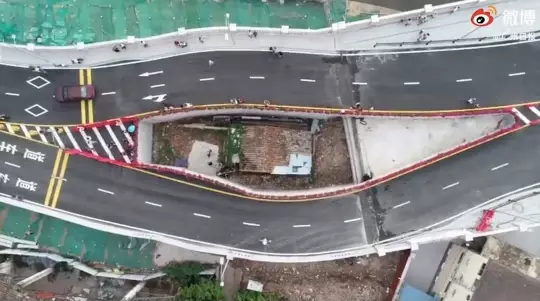Because of the construction of a highway overpass in Guangzhou, China, a homeowner’s little house is now crammed between traffic lanes. Despite offers of alternate accommodation and compensation from the Chinese government, the owner refused to move.
According to reports from Guangzhou locals, they were urged to leave their homes to make way for demolition. One homeowner, Liang, disclosed that she turned down the offer since the government had failed to supply her with a suitable replacement residence in a desirable region.

Liang’s house, often referred to as a “nail house,” is a single-story dwelling with a small 40 square meter (430 square feet) flat. Before the construction of the motorway, the property boasted picturesque views. However, it is now wedged between two lanes of the newly constructed freeway bridge.

In an interview with MailOnline, Liang expressed contentment with her decision to stay, despite the adverse circumstances. She described her environment as quiet, liberating, pleasant, and comfortable.
The decision to demolish Liang’s house and build the Haizhuyong Bridge was made by authorities in 2010, and the construction of the bridge was completed a decade later. However, as of 2023, the tiny nail house remains standing.

Government officials claim that they made numerous offers of alternative housing and compensation plans to the stubborn resident, all of which were rejected. Reports suggest that Liang demanded the government provide her with four apartments, whereas they agreed to offer only two.
Engineers thoroughly assessed the safety risks before allowing Liang to stay. Once it was determined that her residence could withstand the construction process, work on the bridge commenced.
The government has pledged to maintain communication with Liang after the motorway’s completion to ensure her comfort and security in her Guangzhou home.
Among the 47 homes and seven businesses that previously occupied the area, Liang’s house is the sole survivor. According to authorities, all other former residents of Huandao Road had voluntarily relocated and left their homes by September 2019, prior to the bridge’s construction.


